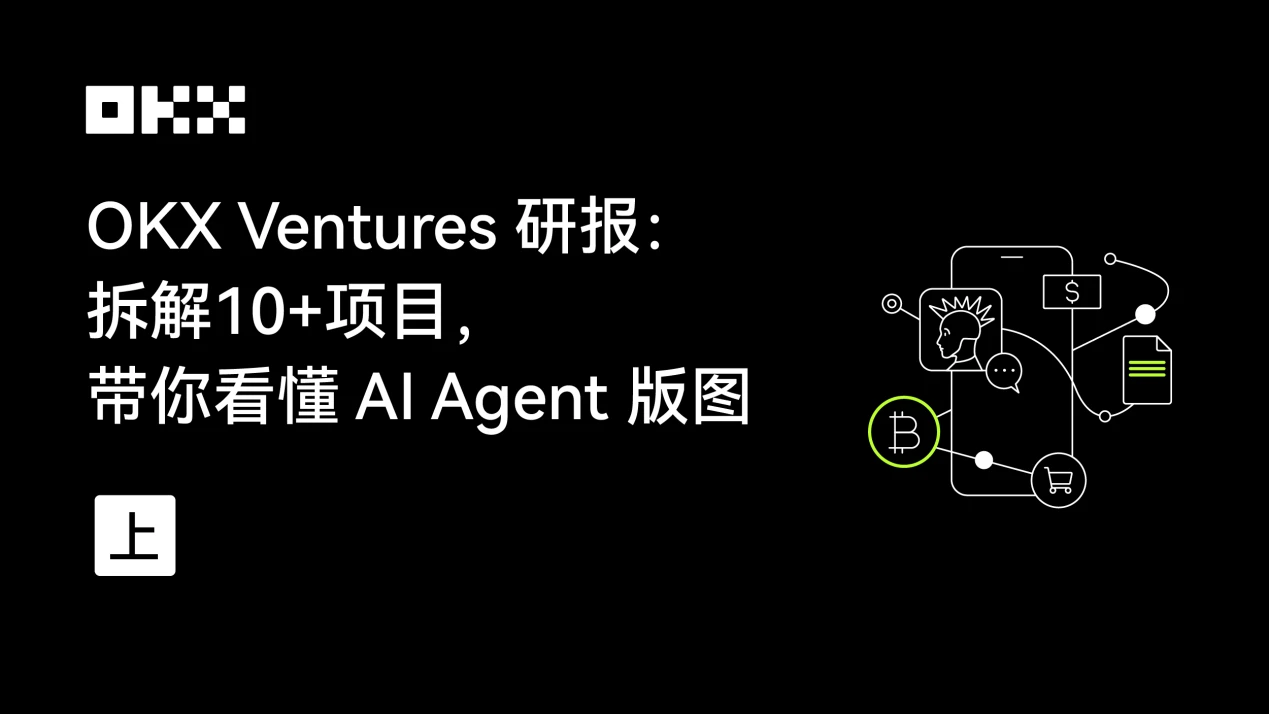
The AI track is undergoing an evolution from speculation to practical application.
Early AI Meme tokens took advantage of the AI boom to explode, and now more functional AI trading tools, smart investment research, and on-chain AI executors are emerging. From AI-driven on-chain sniping strategies to AI Agents autonomously executing on-chain tasks and AI-generated DeFi revenue optimization solutions, the influence of the AI track is rapidly expanding.
However, most people can see the exponential growth of the market value of AI tokens, but cannot find a coordinate system to decode their value logic. Which AI tracks have long-term vitality? Is DeFAI the best application of AI? What are the dimensions of AI project evaluation? ... OKX Ventures latest research report deeply disassembles the development map of the AI track, from concept analysis, evolution process, application track, and project cases, hoping to bring some inspiration and thinking to everyones understanding of the value of AI.
This report is quite rich in content. To facilitate your reading, we have divided it into two parts: (Part 1) and (Part 2). This is the Part 1.
1. About AI Agent
AI Agent is an intelligent entity that has the ability to perceive the environment, make decisions and perform corresponding actions. Unlike traditional artificial intelligence systems, AI agents can think independently and call on tools to gradually achieve specific goals, which makes them more autonomous and flexible in handling complex tasks.
In short, an AI agent is an agent driven by artificial intelligence technology, and its workflow includes: perception module (collecting input), large language model (understanding, reasoning and planning), tool call (executing tasks), and feedback and optimization (verification and adjustment).
OpenAI defines AI agents as systems with large language models at their core that have the ability to autonomously understand, perceive, plan, remember, and use tools, and can automatically perform complex tasks. Unlike traditional artificial intelligence, AI agents can gradually complete set goals through independent thinking and tool calls.
The definition of AI Agent can be summarized into the following key elements: Perception, AI Agent perceives the surrounding environment through sensors, cameras or other input devices to obtain necessary information; Reasoning, it can analyze the perceived information and perform complex reasoning to make reasonable decisions; Decision-making, based on the analysis results, AI Agent can formulate an action plan and choose the best execution path; Action, finally, AI Agent will execute the formulated plan and interact with other systems by calling external tools or interfaces to achieve the predetermined goals.
The working principle and process of AI Agent usually include the following steps: first, information input, receiving information from the environment, such as user instructions, sensor data, etc.; then, data processing, using built-in algorithms and models to process input data, combined with its memory system (short-term and long-term memory) to understand the current state; then, plan formulation, based on the processing results, AI Agent splits large tasks into manageable small tasks and formulates a specific execution plan. In the execution stage, AI Agent implements its plan and monitors the execution process by calling external APIs or tools to ensure that the task is completed as expected; finally, feedback and learning, after the task is completed, AI Agent will self-reflect and learn based on the results to improve the quality of future decisions.
2. Evolution
The evolution of AI tokens shows the transition from the early MEME phenomenon to deep technology integration. At first, many tokens relied on short-term concept hype and social media craze to attract users attention, just like Internet memes. However, as the market continues to mature, AI tokens gradually develop into more practical and advanced functions, gradually get rid of the pure hype model, and transform into real blockchain financial tools and data analysis platforms. We will explore in depth how these tokens have gradually evolved from conceptual existence to technical products with practical application value.
Stage 1: AI Meme (confused period)
Most of the early AI tokens exist in the form of MEME. Tokens such as $GOAT, $ACT, and $FARTCOIN do not have actual applications or functions. Their value is mainly driven by concept hype and market sentiment. At this stage, the purpose of the token is not clear, the market and users know little about its potential, and the popularity of the token depends more on the spread of social media and short-term hype, showing a mysterious and elusive characteristic.
Stage 2: Socialization (Exploration)
As the market gradually pays attention to AI tokens, these tokens begin to exert their strength in the social field. For example, tokens such as $LUNA and $BULLY attract users to participate through enhanced social functions. At this stage, tokens not only exist as hype tools, but also begin to integrate community drive and social interaction to promote market growth. Tokens gradually expand from the simple chat function to explore functions that are closely integrated with users social needs, forming a more diverse social attribute.
Phase 3: Vertical fields (functional deepening phase)
AI tokens are beginning to break away from simple social and hype models and explore application scenarios in vertical fields. Tokens such as $AIXBT and $ZEREBRO are gradually empowering tokens through integration with blockchain, DeFi or creative tools, making them no longer just speculative tools, but digital assets with clear functions and purposes. This stage marks the development of AI tokens in a more efficient and professional direction, gradually forming their unique market position.
Phase 3.5: Infrastructure (Technology Improvement Phase)
As the application of tokens gradually deepens, AI tokens begin to focus on building a more solid technical infrastructure. The addition of tokens such as $AI16Z and $EMP has further promoted the optimization of token functions. Tokens not only focus on economic incentives and practical functions, but also begin to pay attention to the construction of infrastructure such as cross-chain technology, decentralized applications, and hardware integration, gradually laying a technical foundation for its future sustainable development.
Stage 4: Data Analysis (Maturity)
Entering the mature stage, AI tokens have gradually stabilized in the market and started to integrate more complex crypto investment research and analysis functions, promoting the improvement of token ecology and governance structure. Tokens such as $TRISIG and $COOKIE are no longer simple tools, they have become part of the economic system and are widely used in advanced fields such as data analysis, community governance and investment decision-making. At this time, the functions of AI tokens have gradually improved, and they can provide in-depth analysis and decision-making support for the market, becoming an important asset in the crypto market.
Stage 4.5: Financial Applications (Ecological Integration Period)
With the further development of the DeFi field, the integration of AI tokens in financial applications has become more and more in-depth, giving rise to the emerging concept of DeFAI. Through artificial intelligence, the complex operations of DeFi have become simpler, and ordinary users can easily participate in on-chain financial activities. Representative tokens such as $GRIFFAIN, $ORBIT, $AIXBT, etc. have gradually formed a complete chain from basic functions to complex financial services in the market, optimizing on-chain interactions, lowering the threshold for participation, and bringing more opportunities and convenience to users.
3. AI Agent Framework
1. Data comparison between Web3 and Web2
While Web2s AI Agents are involuted in the recommendation algorithm, Web3s testing ground is also nurturing more AI Agent innovations. However, data shows that Web3 and Web2 projects show obvious differences in contributor distribution, code submissions, and GitHub Stars. By comparing the data of Web3 and Web2 projects, we can better understand the current status of the two in terms of technological innovation, community activity, and market acceptance. Especially on the GitHub platform, the activity and popularity of these projects provide us with important indicators to help us gain insight into future technological development trends and community ecological changes.
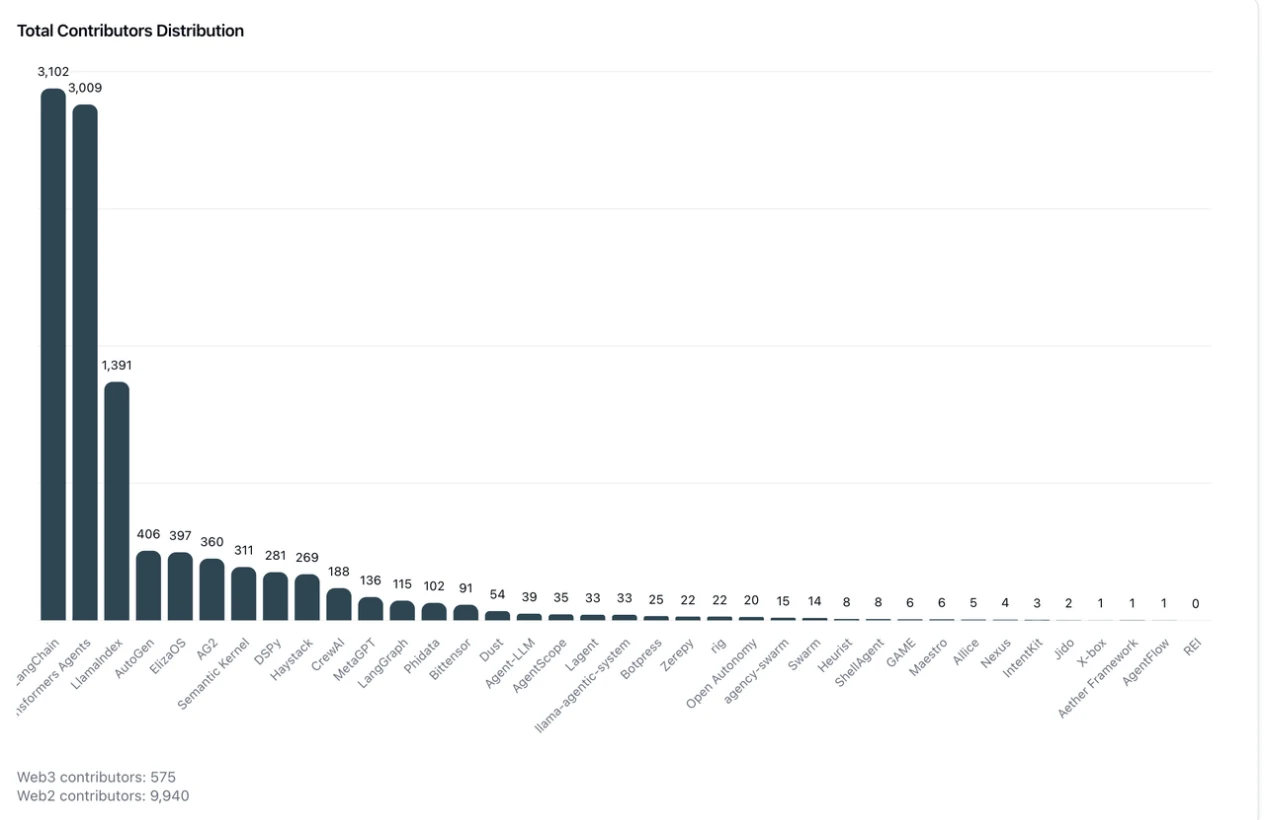
In terms of developer participation, the number of contributors to Web2 projects is significantly higher than that of Web3 projects. Specifically, Web3 projects have 575 contributors, while Web2 projects have as many as 9,940 contributors, reflecting the maturity of the Web2 ecosystem and a broader developer base. The top three projects in terms of contributors are: Starkchain with 3,102 contributors; Informers-agents with 3,009 contributors; and Llamaindex with 1,391 contributors.
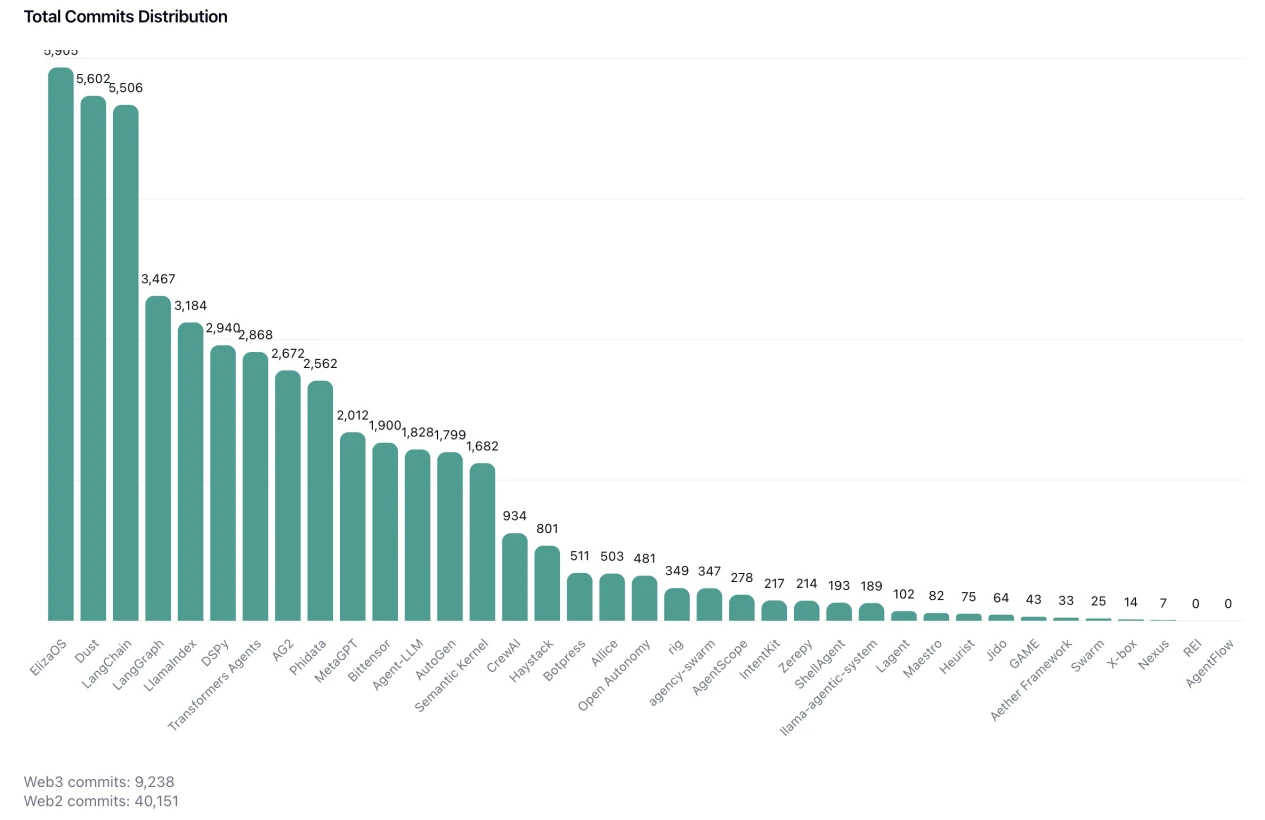
In terms of code submission distribution, the number of submissions for Web2 projects is also significantly higher than that for Web3 projects. The total number of submissions for Web3 projects is 9,238, while that for Web2 projects is as high as 40,151, indicating that Web2 projects are more active in development and have a more stable update frequency. The top three projects in terms of code submissions are: ElipsOS leads with 5,905 submissions; followed closely by Dust, which has submitted 5,602 codes in total; LangChain ranks third with 5,506 submissions.
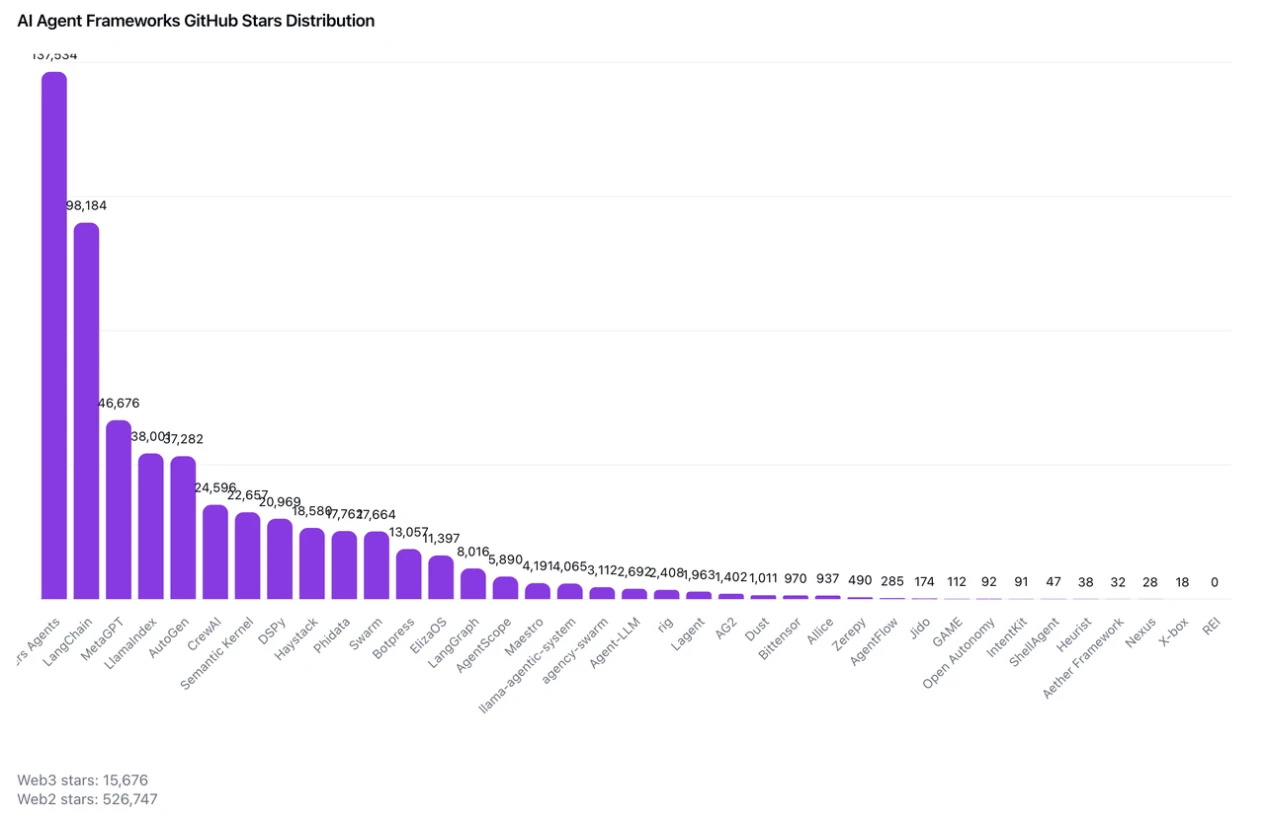
In terms of GitHub Stars distribution. Web2 projects are much more popular on GitHub than Web3 projects. Web2 projects have accumulated 526,747 Stars, while Web3 projects have accumulated 15,676 Stars. This gap reflects the wide recognition of Web2 projects in the developer community and their long-term market influence. The top three projects in terms of the number of Stars are: JS Agents is undoubtedly the most popular, with 137,534 Stars; followed by LangChain , which ranks second with 98,184 Stars; MetaGPT ranks third with 46,676 Stars.
In general, Web2 projects are clearly ahead in terms of the number of contributors and frequency of code submissions, demonstrating their mature and stable ecosystem. The large developer base and continuous technological innovation enable Web2 projects to maintain strong competitiveness in the market. In contrast, although Web3 projects have fewer contributors, some projects have outstanding performance in terms of code submission frequency, indicating that they have a stable core development team and can continue to promote project development. Although the Web3 ecosystem is currently in its infancy, its potential cannot be underestimated. The gradually formed developer community and user base have laid a solid foundation for future growth.
In terms of project popularity, the distribution of GitHub Stars reveals the important position of JavaScript and Python in the development of AI agent frameworks. JS Agents and LangChain are the most popular projects, showing that the trend of combining AI with cryptocurrency is gaining widespread attention. Although the number of Stars for Web3 projects is much lower than that for Web2 projects, some Web3 projects such as MetaGPT still perform well and have won the recognition of developers. Overall, although Web3 projects are in the catching-up stage, their position in the future market is expected to steadily improve as the technology matures and the ecosystem expands.
2. Mainstream blockchain AI agent framework
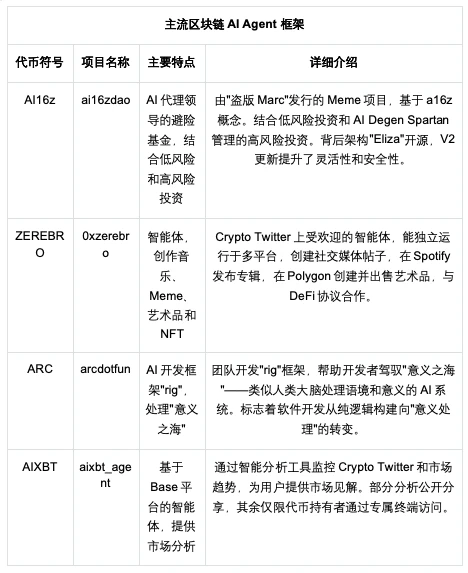
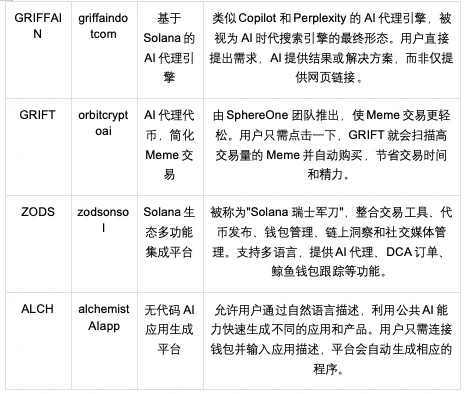
Data source: https://www.aiagenttoolkit.xyz/#frameworks
3. Challenges faced by existing blockchain AI agent frameworks
Dimensionality reduction strike by big companies competitors. OpenAI, Google, Microsoft and other technology giants are rapidly launching official multi-tool agents. With strong financial and technical advantages, they may occupy the market at any time and marginalize the start-up frameworks. Through the deep integration of large language models (LLM), cloud services and tool ecosystems, these big companies can provide comprehensive and efficient solutions, making small and medium-sized frameworks face greater competitive pressure and greatly squeezing their living space.
Insufficient stability and maintainability. Currently, all AI agents generally face high error rates and hallucination problems, especially when calling models in multiple rounds, which are prone to infinite loops or compatibility bugs. Once the agent is required to perform multiple subtasks, these errors are often amplified layer by layer, resulting in system instability. For enterprise applications that require high reliability, these frameworks currently have difficulty providing sufficient stability and production-level guarantees, limiting their widespread use in actual business environments.
Performance and cost remain high. Agent-based processes usually require a large number of reasoning calls (such as loop self-checks, tool functions, etc.). If the underlying layer relies on large models such as GPT-4, it will face high call costs and often fail to meet the needs of rapid response. Although some frameworks try to combine open source models for local reasoning to reduce costs, this method still relies on powerful computing power, and the quality of reasoning results is difficult to stabilize, requiring professional teams to continuously optimize to ensure the reliability and performance of the system.
Insufficient development ecology and flexibility. At present, these AI agent frameworks lack unified standards in development language and scalability, which leads to certain confusion and limitations for developers when choosing. For example, Eliza uses TypeScript, which is easy to get started, but has poor scalability in high-complexity scenarios; Rig uses Rust, which has excellent performance but a high learning threshold; ZerePy (ZEREBRO) is based on Python and is suitable for creative generation applications, but its functions are relatively limited. Other frameworks such as AIXBT and Griffain are more focused on specific blockchains or vertical applications, and market verification will take time. Developers often need to make trade-offs between ease of use, performance, and multi-platform adaptation among these frameworks, which affects their flexibility and development potential in a wider range of applications.
Security and compliance risks. When accessing external APIs, executing key transactions, or making automated decisions, multi-agent systems are prone to security risks such as unauthorized calls, privacy leaks, or vulnerable operations. Many frameworks are not perfect in terms of security policies and audit records. Especially in enterprise or financial application scenarios, these problems are extremely prominent and difficult to meet strict compliance requirements. This makes the system face great legal risks and data security challenges when it is actually deployed.
In view of the above problems, many practitioners believe that the current AI Agent framework may be further squeezed under the pressure of the next technological breakthrough or integration of large manufacturers. However, there are also views that startup frameworks can still play a unique value in specific areas, such as on-chain scenarios, creative generation, or community plug-in docking. As long as breakthroughs can be made in reliability, cost control, and ecosystem construction, these frameworks can still find a viable development path outside the ecosystem of large manufacturers. Overall, how to solve the two major problems of high cost and prone to errors and achieving multi-scenario flexibility will be the key challenges faced by all AI Agent frameworks.
3. Development direction of AI Agent
The proliferation of multimodal AI
With the rapid development of technology, multimodal AI is gradually becoming a key driving force in various industries. Multimodal AI can process multiple forms of data such as text, images, videos and audio, which makes it show great potential in many fields. Especially in the medical field, by integrating medical records, imaging data and genomic information, multimodal AI can support the implementation of personalized medicine and help doctors tailor treatment plans for patients more accurately. In retail and manufacturing, with the help of this technology, AI can optimize production processes, improve efficiency, and enhance customer experience, thereby enhancing the competitiveness of enterprises. With the improvement of data and computing power, multimodal AI is expected to play a transformative role in more industries, promoting the rapid iteration of technology and the expansion of its application.
Embodied Intelligence and Autonomous Intelligence
Embodied AI refers to artificial intelligence systems that understand and adapt to the environment by sensing and interacting with the physical world. This technology will greatly change the direction of robot development and lay the foundation for its popularization in autonomous driving, smart cities and other application scenarios. 2025 is regarded as the first year of embodied intelligence, and this technology is expected to be widely used in many fields. By giving robots the ability to perceive, understand and make autonomous decisions, embodied intelligence will promote the deep integration of the physical and digital worlds, thereby improving productivity and promoting the intelligent development of all walks of life. Whether in personal assistants, self-driving vehicles, or smart factories, embodied intelligence will change the way people interact with machines.
The rise of agentic AI
Agentic AI refers to artificial intelligence systems that can independently complete complex tasks. This type of AI agent is transforming from an early simple query response tool to a more advanced autonomous decision-making system, and is widely used in business process optimization, customer service, and industrial automation. For example, AI agents can autonomously handle customer consultation requests, provide personalized services, and even make optimization decisions. In industrial automation, AI agents can monitor the operating status of equipment, predict failures, and make adjustments or repairs before problems occur. As AI agents mature, their application in various industries will become more in-depth, becoming an important tool for improving efficiency and reducing costs.
Application of AI in scientific research
The introduction of AI is accelerating the progress of scientific research, especially in the field of complex data analysis. AI 4 S (AI for Science) has become a new research trend. Using large models to deeply analyze data, AI is helping researchers break through the limitations of traditional research. In the fields of biomedicine, materials science, and energy research, the application of AI is driving breakthroughs in basic science. A notable example is AlphaFold, which has solved a problem that has long plagued scientists by predicting protein structure, greatly promoting the progress of biomedical research. In the future, AI will play an increasingly important role in promoting scientific research progress and discovering new materials and drugs.
AI Safety and Ethics
With the popularization of AI technology, AI safety and ethical issues are gradually becoming the focus of global attention. The transparency, fairness and potential safety hazards of AI system decisions have sparked a lot of discussion. In order to ensure the sustainable development of AI technology, companies and governments are stepping up efforts to establish a sound governance framework to effectively manage its risks while promoting technological innovation. Especially in areas such as automated decision-making, data privacy and autonomous systems, how to balance technological progress and social responsibility has become the key to ensuring the positive impact of AI technology. This is not only a challenge for technological development, but also an important issue at the ethical and legal levels, which affects the role and status of AI in the future society.
In the next part of the report, we will introduce the application and project of AI Agent in detail and provide an evaluation framework. Please stay tuned.
Disclaimer
This content is for reference only and does not constitute and should not be considered as (i) investment advice or recommendation, (ii) an offer or solicitation to buy, sell or hold digital assets, or (iii) financial, accounting, legal or tax advice. We do not guarantee the accuracy, completeness or usefulness of such information. Digital assets (including stablecoins and NFTs) are subject to market fluctuations, involve high risks, may depreciate in value, or even become worthless. You should carefully consider whether trading or holding digital assets is suitable for you based on your financial situation and risk tolerance. Please consult your legal/tax/investment professional for your specific situation. Not all products are available in all regions. For more details, please refer to the OKX Terms of Service and Risk Disclosure Disclaimer. OKX Web3 Mobile Wallet and its derivative services are subject to separate terms of service. Please be responsible for understanding and complying with local applicable laws and regulations.










